Study on the Synergistic Effect of Primary Support and Surrounding Rock of Large Buried Depth Tunnel in Soft and Fractured Strata
Abstract
:1. Introduction
2. Study Area and Methods
2.1. Investigation
2.2. Monitoring Scheme
2.2.1. Monitoring Point Arrangement
2.2.2. Monitoring Methodology
2.3. Modeling
3. Monitoring and Verification
3.1. Simulation Analysis
3.1.1. Stress Field Analysis
3.1.2. Displacement Field Analysis
3.2. Comparative Analysis of Monitoring and Simulation
3.2.1. Comparative Analysis of Earth Pressure Cell
- (1)
- Figure 8 demonstrates that the stress values at each monitoring point of the steel arch support exhibit a rapid increase in the first 8 m of excavation, followed by a slower and converging change over the subsequent 12 m. This phenomenon results from the stress redistribution in the surrounding rock post-tunnel excavation, transferring stress to the steel arch supports. In later stages, the stress in the surrounding rock stabilizes, and the pressure on the steel arch supports also reaches a steady state.
- (2)
- When comparing the field monitoring data to the numerical simulation results, both sets of results exhibit a consistent trend. However, the simulation results tend to be slightly higher than the monitoring ones. The observed stress values range from −5.86 to −18.92 MPa, whereas the simulated stress values fluctuate between −6.07 and −23.33 MPa. The maximum pressure on the steel arch supports is noted at the arch ribs on both sides, with decreased pressure at the arch shoulders. The minimum pressure is experienced at the crown of the steel arch supports. The left arch rib endures marginally more pressure than its right counterpart. This analysis infers that the surrounding rock at the crown position undergoes some relaxation and possesses a diminished load-bearing capacity. Consequently, the surrounding rock at the arch rib location exerts the maximum resistance force on the steel arch supports. This force is followed in magnitude by the force at the arch shoulder position, with the crown position experiencing the least pressure.
3.2.2. Comparative Analysis of Steel Strain Gauge
- (1)
- The curve trends derived from field monitoring tests and numerical simulations (Figure 9) indicate that the strain values of the steel arch support diminish progressively from the crown to the arch rib monitoring points. The peak deformation value registers at 4.19 cm at the crown, and the stable deformation measure approximates 4.08 cm. The data reveal that the strain at the crown surpasses the strain at the 60° position on the right side. This value exceeds the strain at the arch’s shoulder and rib. The monitoring values at each point initially surge then gradually decrease in their rate of increase until achieving stability.
- (2)
- When comparing the field monitoring data to the numerical simulation results, both sets of results exhibit a consistent trend. However, the highest stable value derived from the numerical simulation slightly exceeds the monitoring test results, implying that the steel arch supports undergo elevated pressure and more significant displacements during the actual support process.
3.2.3. Comparative Analysis of Bolt Dynamometer
- (1)
- The axial forces measured at various positions of the steel arch supports are positive, indicating a tensile state. At the same monitoring point, the sensors at deeper depths register smaller anchor rod axial forces. Compared to sensors at greater depths at the same monitoring point, those near the crown record the highest values. For instance, at a depth of 0.5 m from the crown, the axial force is 69.02 kN; at 1.5 m, it is 50.65 kN, and at 2.5 m, it is 34.87 kN. This suggests a trend in which the axial force at 0.5 m is greater than that at 1.5 m, which is greater than that at 2.5 m. In addition, as the monitoring point transitions from the crown to the arch’s rib, the consistent values of the anchor rod axial forces on the same side exhibit a descending trend: the crown axial force surpasses the arch shoulder axial force, which exceeds the arch rib axial force.
- (2)
- A comparison of field monitoring data with numerical simulation results indicated that, at the same depth of 0.5 m, the observed axial forces predominantly range from 19.04 to 46.57 kN. The patterns in both datasets are broadly similar, though the actual monitoring outcomes are marginally lower than the simulated values. This suggests that the numerical simulation model and the chosen parameters for the surrounding rock lining are appropriate.
3.3. Performances as Built
4. Conclusions
- (1)
- The stress variations in the monitoring test exhibited a pattern of a steep increase, followed by a gradual decrease with continuous excavation. In the first 8 m of excavation, there was a pronounced increase in stress, succeeded by a decelerated growth rate in the subsequent 12 m, ultimately stabilizing. This pattern suggests that the initial stress changes rapidly due to the stress release from tunnel excavation. As time progresses, the stress redistributes and gradually stabilizes.
- (2)
- The deformation of the surrounding rock post-tunnel excavation was suboptimal. However, through the analysis of optimized support conditions, the simulated crown displacement was decreased to 0.16 cm, achieving a reduction of 96% relative to the original scheme. In softer and more intricate geological layers, the displacement was minimized to 0.52 cm, reflecting a reduction of 87%. This optimization scheme can enhance construction safety. Regarding the existing support system, the peak stress on the monitored steel arch was −18.92 MPa, suggesting compression. The optimization thus involved reinforcing the support with H150 steel arches in a closer arrangement. Since shotcrete support was not utilized during construction, monitoring and numerical simulation indicated that the axial force at the crown could attain 69.02 kN. Hence, in actual construction scenarios, anchor rods should be integrated promptly post-initial support, followed by shotcrete application to establish a comprehensive shotcrete support system.
Author Contributions
Funding
Institutional Review Board Statement
Informed Consent Statement
Data Availability Statement
Conflicts of Interest
References
- Lai, H.P.; Zhao, M.K.; Liu, Y.Y.; Hong, Q.Y.; Huang, Z.P.; Shen, P.X. Dynamic mechanism of surrounding rock and support of large-section tunnel passing through soft-plastic loess layer based on measured date. J. Traffic Transp. Eng. 2023, 23, 115–131. (In Chinese) [Google Scholar]
- Yin, Z.Z. Application of Hydrostatic Leveling System in Metro Monitoring for Construction Deep Excavation above Shield Tunnel. Appl. Mech. Mate 2013, 333–335, 1509–1513. [Google Scholar] [CrossRef]
- Buchmayer, F.; Monsberger, C.M.; Lienhart, W. Advantages of tunnel monitoring using distributed fibre optic sensing. J. Appl. Geod. 2021, 15, 1–12. [Google Scholar] [CrossRef]
- Li, K.; Jia, C.; Di, S.T.; Zhang, J.P.; Yu, W.J. Monitoring Analysis on the Mechanical Properties for Tunnel Support System under Full Section Excavation. Chin. J. Undergr. Space Eng. 2018, 14, 860–868. (In Chinese) [Google Scholar]
- Chen, X.N.; Xiong, X.Y.; Liu, J.L.; Wang, J.C. Stability Analyses of Yuanbazi Tunnel Surrounding Rocks Based on Field Monitoring. Sci. Technol. Eng. 2017, 17, 311–314. (In Chinese) [Google Scholar]
- Zheng, Z.P.; Lei, Y. Structural Monitoring Techniques for the Largest Excavation Section Subsea Tunnel: Xiamen Xiang’an Subsea Tunnel. J. Aerosp. Eng. 2016, 30, B4016002. [Google Scholar] [CrossRef]
- Tan, Z.S.; Yu, Y.; Wang, M.N.; Yang, J.M. Experimental Research on Bolt Anchorage effect on Large-Section Deep-Buried Tunnel in Loess. Chin. J. Rock Mech. Eng. 2008, 08, 1618–1625. (In Chinese) [Google Scholar]
- Lai, H.P.; Xie, Y.L.; Yang, X.H. Mechanical characteristic of highway tunnel in loess. J. Chang. Univ. (Nat. Sci. Ed.) 2005, 6, 53–56. (In Chinese) [Google Scholar]
- MacPherson, W.N.; Silva-Lopez, M.; Barton, J.S.; Moore, A.J.; Jones, J.D.C.; Zhao, D.; Zhang, L.; Bennion, I.; Metje, N.; Chapman, D.N.; et al. Tunnel monitoring using multicore fibre displacement sensor. Meas. Sci. Technol. 2006, 17, 1180–1185. [Google Scholar] [CrossRef]
- Huang, M.L.; Xu, F.; Wu, Z.Y. Monitoring and Analysis of Influence of TBM Construction on Surrounding Rock Stability Under Urban Environment and Supporting Parameters Optimization. Chin. J. Rock Mech. Eng. 2012, 31, 1325–1333. (In Chinese) [Google Scholar]
- Yun, H.B.; Park, S.H.; Mehdawi, N.; Mokhtari, S.; Chopra, M.N.; Reddi, L.N.; Park, K. Monitoring for close proximity tunneling effects on an existing tunnel using principal component analysis technique with limited sensor data. Tunn. Undergr. Space Technol. 2014, 43, 398–412. [Google Scholar] [CrossRef]
- Slabej, M.; Grinč, M.; Kováč, M.; Decký, M.; Šedivý, S. Non-invasive diagnostic methods for investigating the quality of Žilina airport’s runway. Contrib. Geophys. Geod. 2015, 45, 237–254. [Google Scholar] [CrossRef]
- Kavvadas, M. Monitoring ground deformation in tunnelling: Current practice in transportation tunnels. Eng. Geol. 2005, 79, 93–113. [Google Scholar] [CrossRef]
- Oreste, P.; Oggeri, C. Tunnel static behavior assessed by a probabilistic approach to the back-analysis. Am. J. Appl. Sci. 2012, 9, 1137–1144. [Google Scholar]
- Khelalfa, H.; Aykan, B.; Boulmaali, H. Monitoring of tunnel rock mass deformations during provisional support stage: A case study. Rev. Min.–Min. Rev. 2022, 28, 1–23. [Google Scholar] [CrossRef]
- Hong, Z.Q.; Zhang, J.; Han, L.; Wu, Y.H. Numerical Study on Water Sealing Effect of Freeze-Sealing Pipe-Roof Method Applied in Underwater Shallow-Buried Tunnel. Front. Phys. 2022, 9, 794374. [Google Scholar] [CrossRef]
- Xu, J.B.; Jiang, P.; Zhu, S.Y.; Fan, R.; Zhou, Q.L.; Hu, J. Analysis of initial support effect of tunnel based on on-site monitoring and numerical simulation Method. Sci. Technol. Eng. 2020, 20, 2061–2069. (In Chinese) [Google Scholar]
- Chen, D.X.; Wang, L.G.; Sun, C.; Jia, C.Z.; Zheng, L.X. Investigation of the support constraint effect and failure instability law of tunnels constructed using the New Austrian tunneling method. Sci. Rep. 2022, 12, 5811. [Google Scholar] [CrossRef]
- Wang, L.M.; Li, F.Y.; Zhang, B.; Wen, B.; Yang, G. Mechanical property and stability of tunnel boring machine tunnel steel arch support field test. Sci. Technol. Eng. 2020, 20, 14223–14228. (In Chinese) [Google Scholar]
- Guo, H.Y.; Yan, Y.; Ding, H.; Liu, X.R.; Yang, M. Development and application of automatic monitoring equipment for differential deformation of element joint in immersed tunnel. Front. Phys. 2023, 11, 1134431. [Google Scholar] [CrossRef]
- Zhu, D.; Zhu, Z.D.; Zhang, C.; Dai, L.; Wang, B.T. Numerical simulation and field monitoring analysis for tunnel construction based on FLAC3D. Comput. Model. Eng. Sci. 2024, 138, 2445–2470. [Google Scholar]
- Xu, L.S. Numerical Simulation of Surrounding Rock Deformation and Grouting Reinforcement of Cross-Fault Tunnel under Different Excavation Methods. J. Chongqing Jiaotong Univ. (Nat. Sci.) 2009, 28, 528–530. (In Chinese) [Google Scholar]
- Lai, H.P.; Xie, Y.L.; Yang, X.H. Numerical Simulation for Soft-Weak Surrounding Rocks Tunnel Construction Mechanical Characteristics of Different Stress Field. Highway 2009, 10, 239–244. (In Chinese) [Google Scholar]
- Martinelli, D.; Insana, A. Application of a Finite-Discrete Element Method Code for Modelling Rock Spalling in Tunnels: The Case of the Lyon-Turin Base Tunnel. Appl. Sci. 2024, 14, 591. [Google Scholar] [CrossRef]
- Zhang, J.; Mei, M.; Wang, J.; Shang, G.; Hu, X.; Yan, J.; Fang, Q. The Construction and Application of a Deep Learning-Based Primary Support Deformation Prediction Model for Large Cross-Section Tunnels. Appl. Sci. 2024, 14, 912. [Google Scholar] [CrossRef]
- Li, Y.; Zou, Z. Numerical Investigation on the Influence of Super-Large-Diameter Shield Tunneling on Nearby Existing Metro Tunnels and the Protection Scheme. Appl. Sci. 2023, 13, 13179. [Google Scholar] [CrossRef]


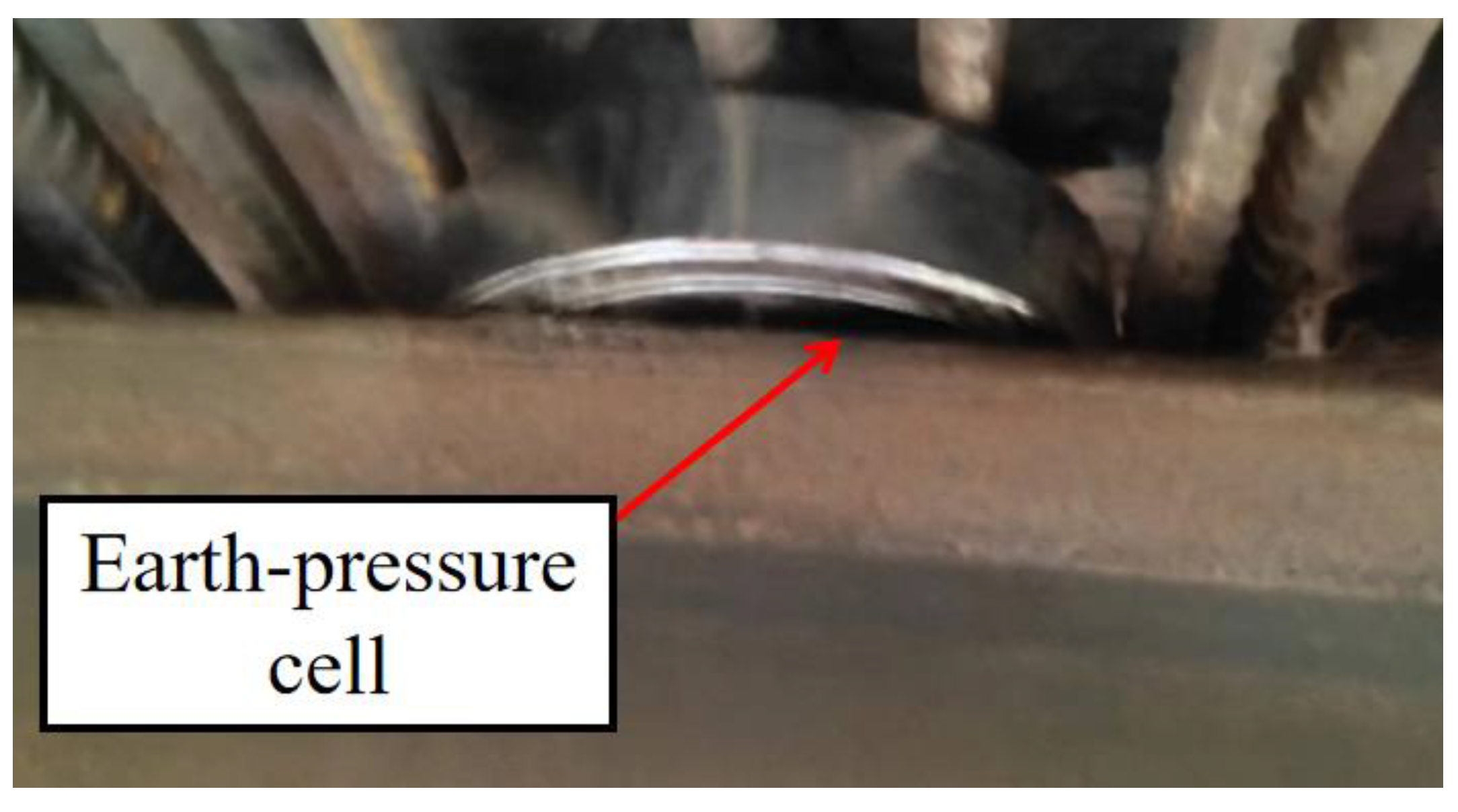

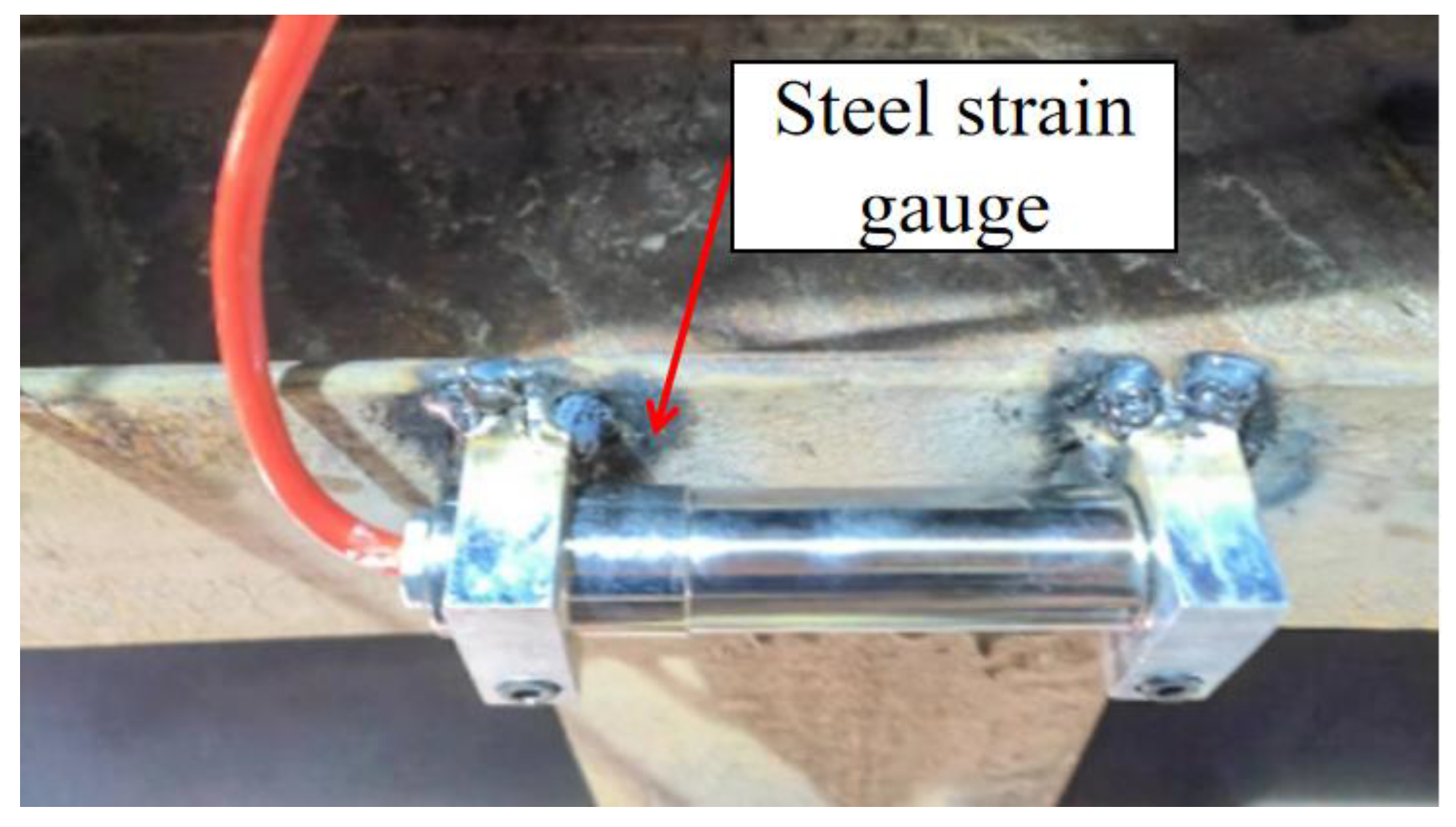

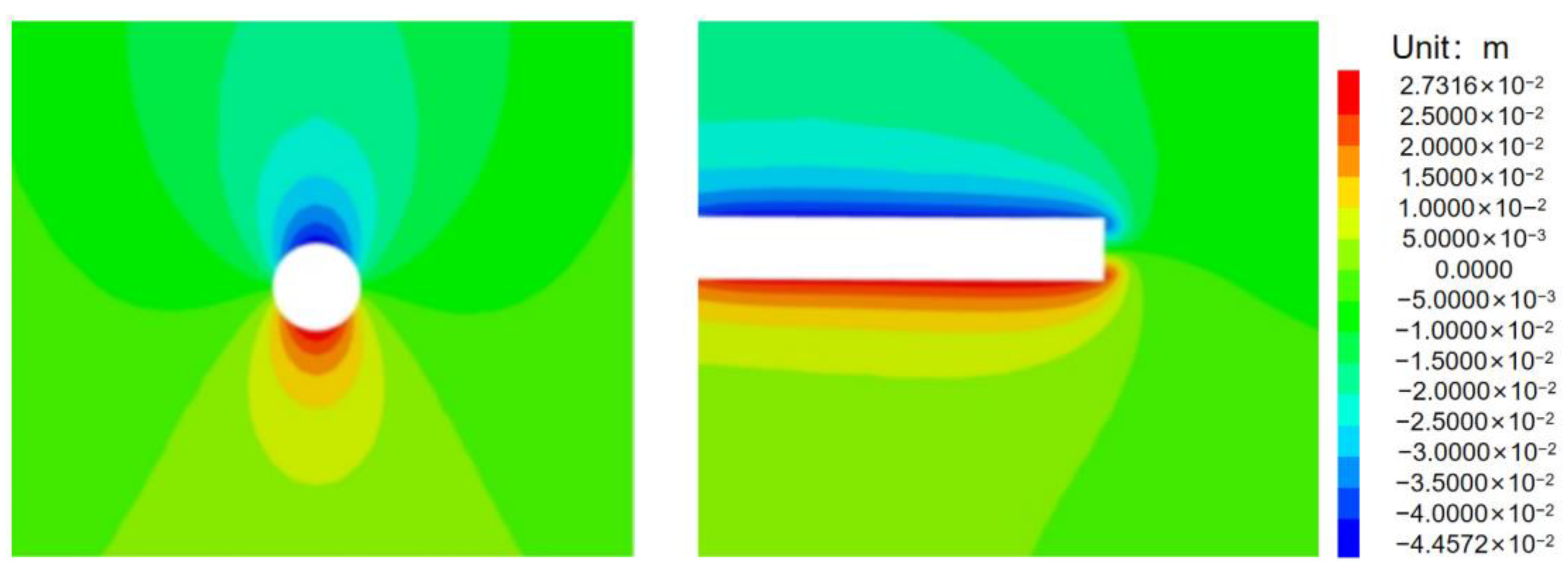

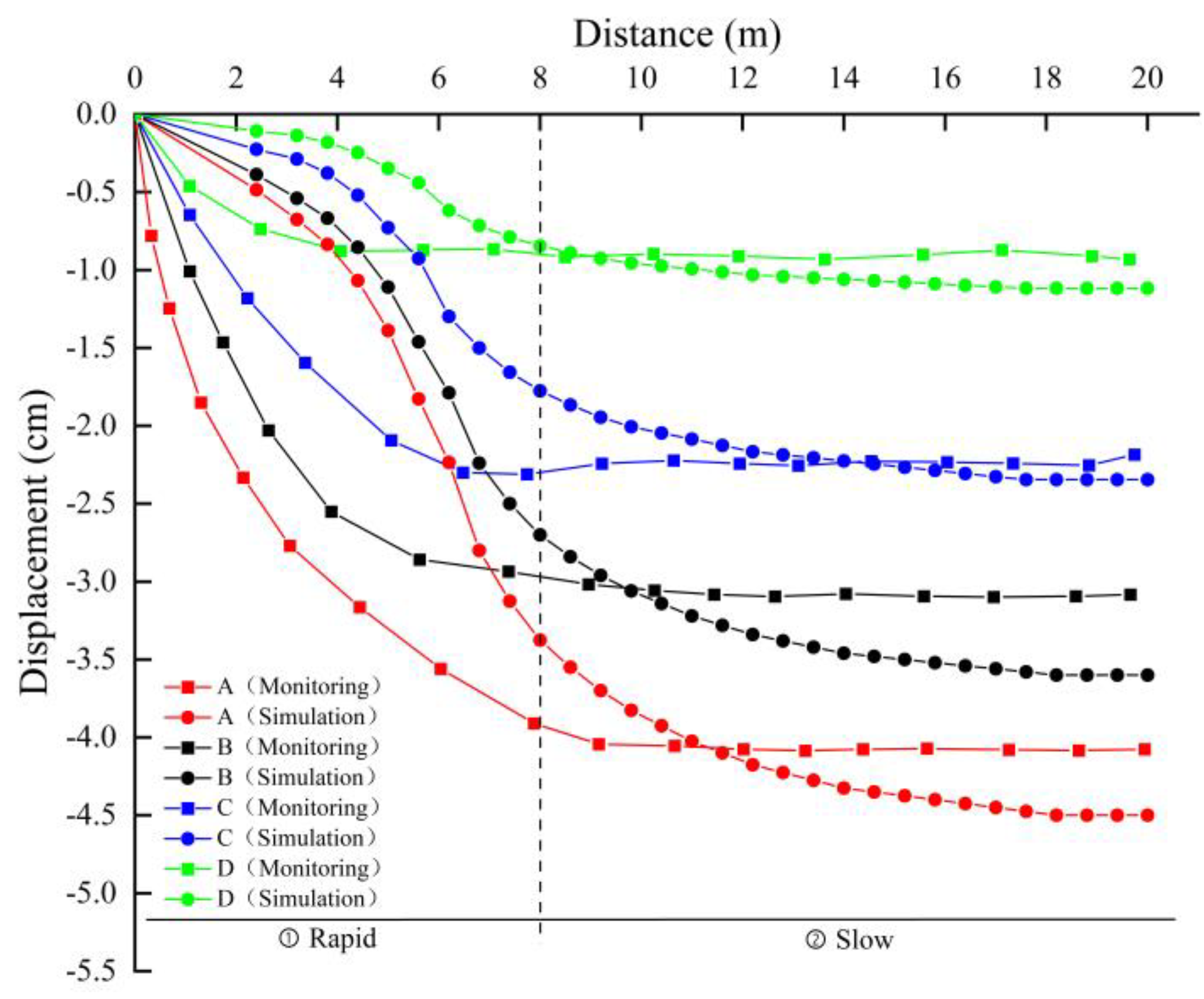
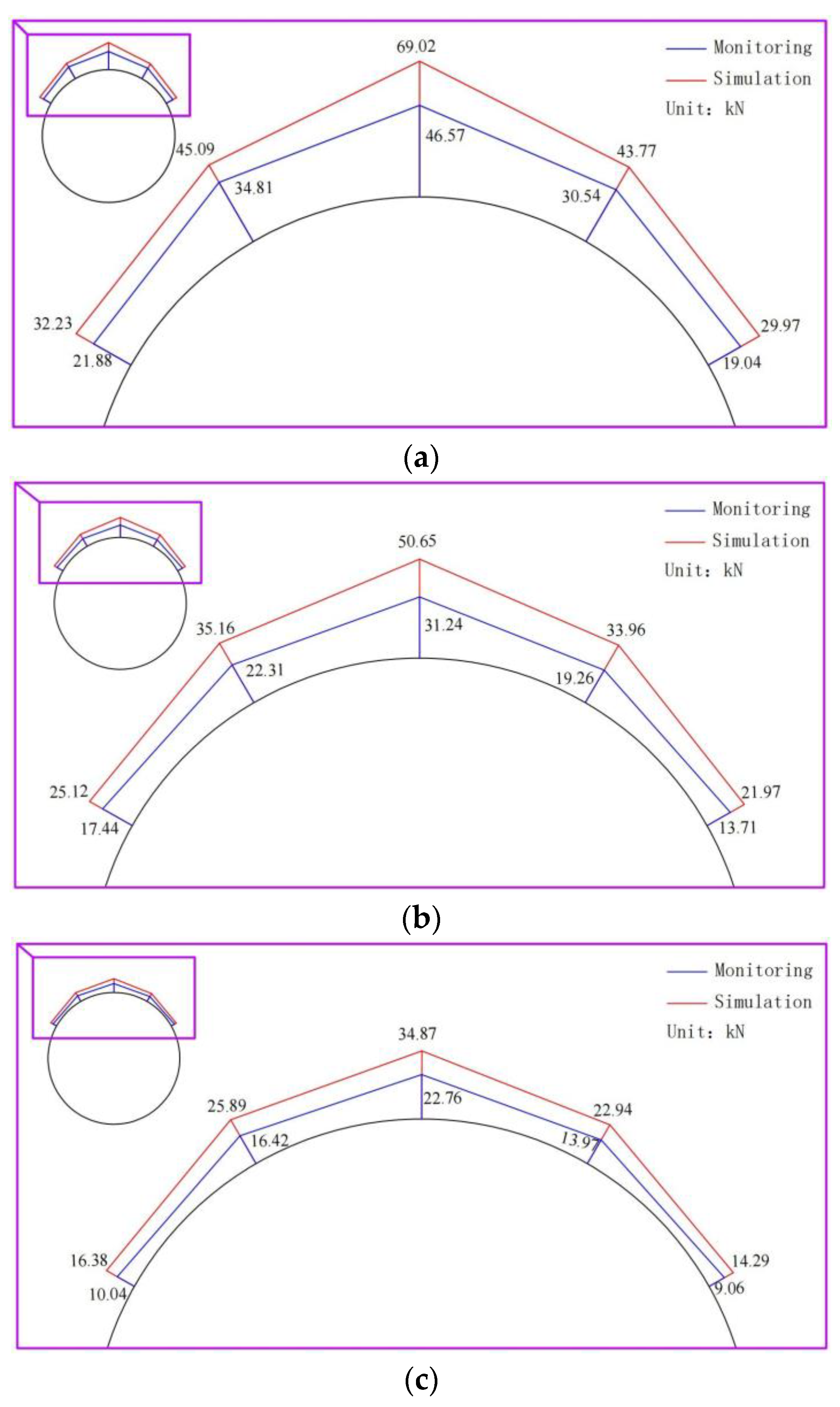
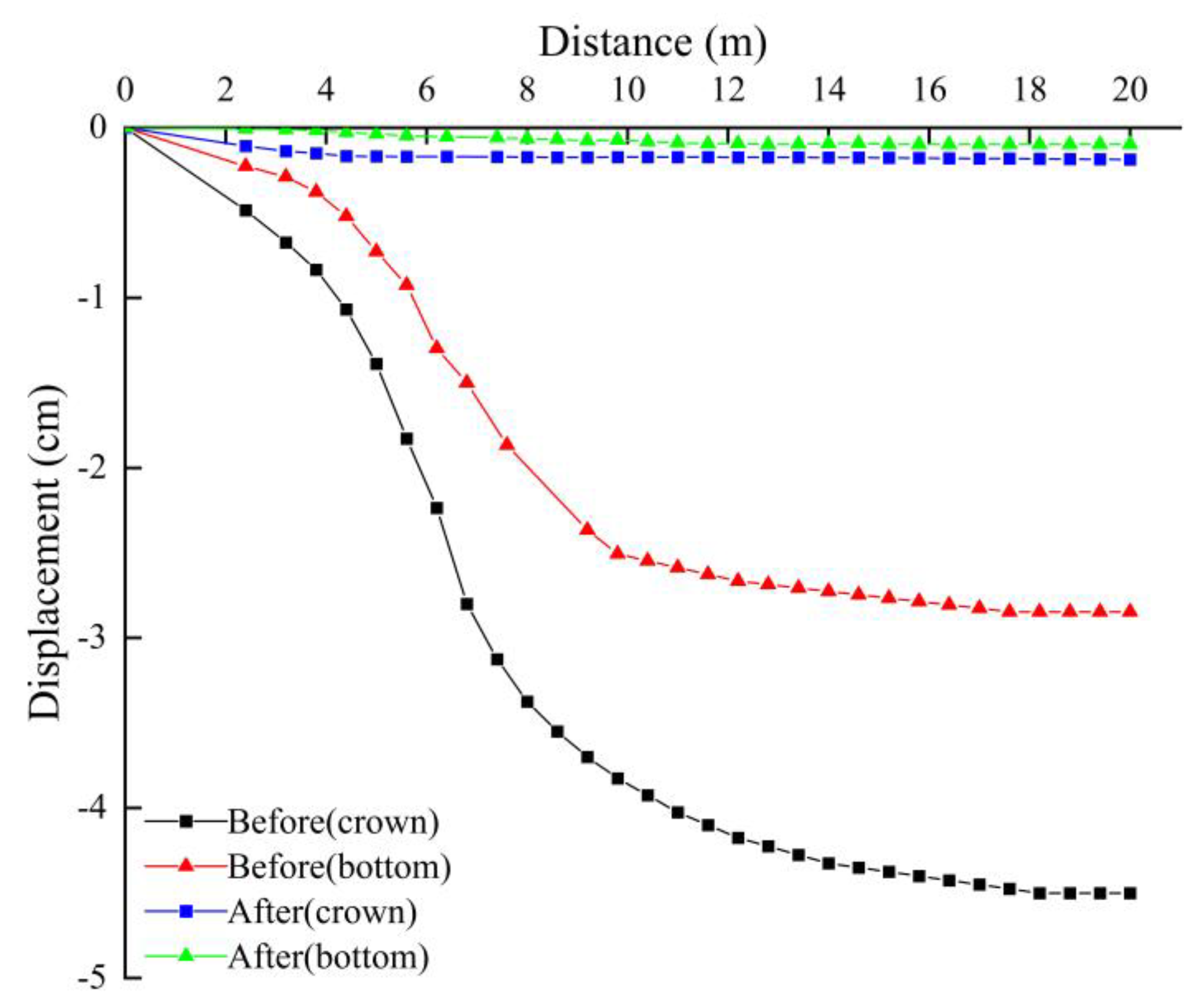

| Media Type | Density (kg/m3) | Young’s Modulus (Pa) | Poisson | Friction (°) | Cohesion (MPa) |
|---|---|---|---|---|---|
| Upper mud shale | 2200 | 5 × 109 | 0.35 | 18 | 0.12 |
| Lower limestone | 2660 | 1.5 × 1010 | 0.32 | 25 | 0.3 |
| Steel Arch Type | Concrete Type | The Spacing of the Steel Arch | |
|---|---|---|---|
| Before | H125 | C25, 20 cm | 1 m |
| After | H150 | C30, 35 cm | 0.5 m |
Disclaimer/Publisher’s Note: The statements, opinions and data contained in all publications are solely those of the individual author(s) and contributor(s) and not of MDPI and/or the editor(s). MDPI and/or the editor(s) disclaim responsibility for any injury to people or property resulting from any ideas, methods, instructions or products referred to in the content. |
© 2024 by the authors. Licensee MDPI, Basel, Switzerland. This article is an open access article distributed under the terms and conditions of the Creative Commons Attribution (CC BY) license (https://creativecommons.org/licenses/by/4.0/).
Share and Cite
Wang, T.; Liu, H.; Kang, M.; Zhao, B.; Shen, J.; Li, Y.; Yang, Y. Study on the Synergistic Effect of Primary Support and Surrounding Rock of Large Buried Depth Tunnel in Soft and Fractured Strata. Appl. Sci. 2024, 14, 2028. https://doi.org/10.3390/app14052028
Wang T, Liu H, Kang M, Zhao B, Shen J, Li Y, Yang Y. Study on the Synergistic Effect of Primary Support and Surrounding Rock of Large Buried Depth Tunnel in Soft and Fractured Strata. Applied Sciences. 2024; 14(5):2028. https://doi.org/10.3390/app14052028
Chicago/Turabian StyleWang, Tianyi, Haining Liu, Minglei Kang, Benchao Zhao, Jixian Shen, Yingchun Li, and Yandong Yang. 2024. "Study on the Synergistic Effect of Primary Support and Surrounding Rock of Large Buried Depth Tunnel in Soft and Fractured Strata" Applied Sciences 14, no. 5: 2028. https://doi.org/10.3390/app14052028





